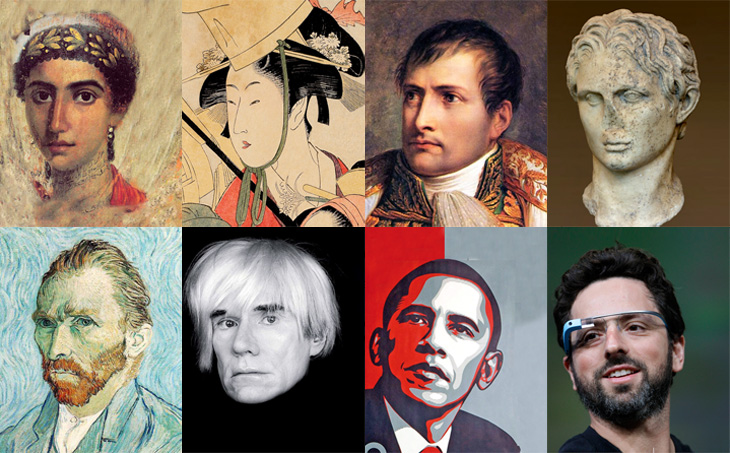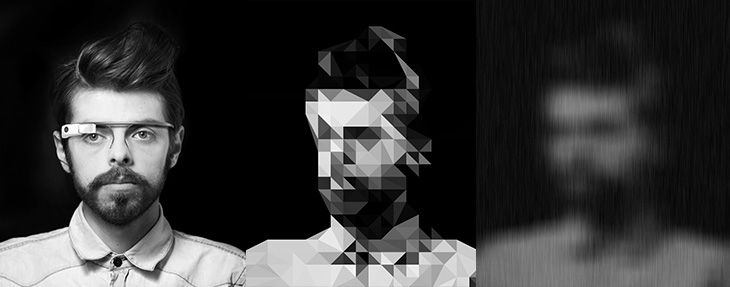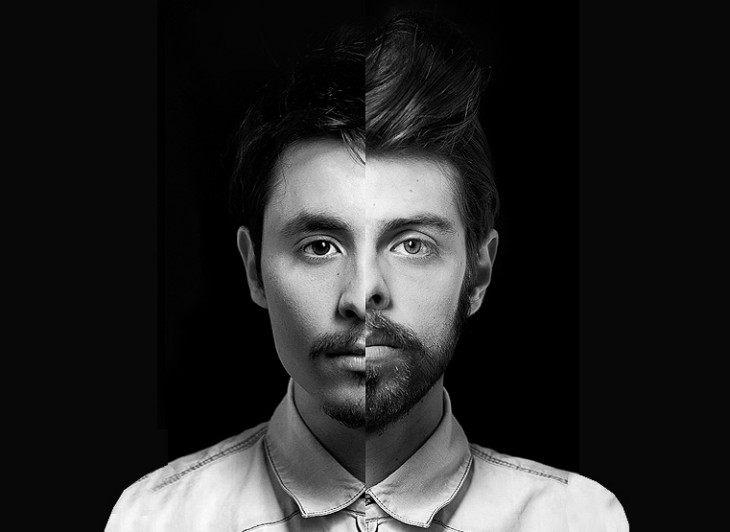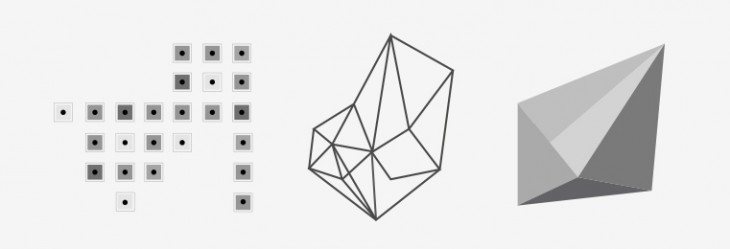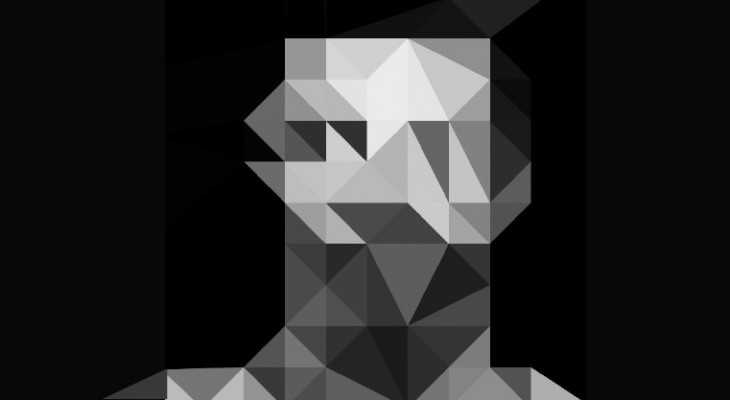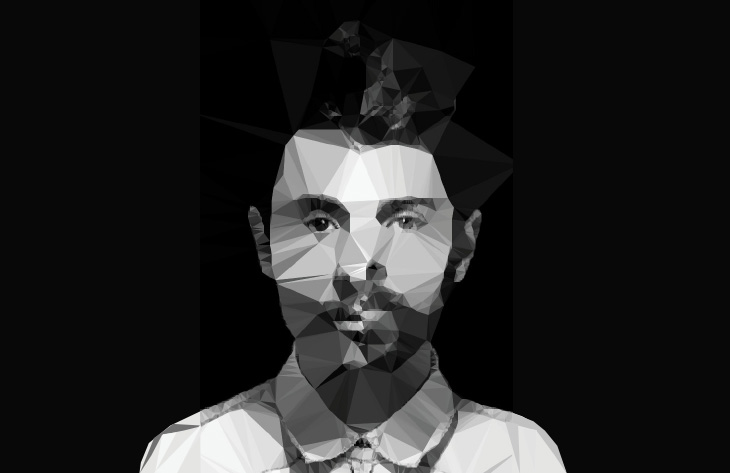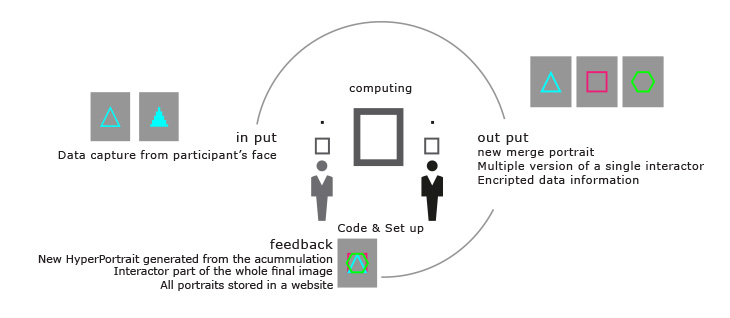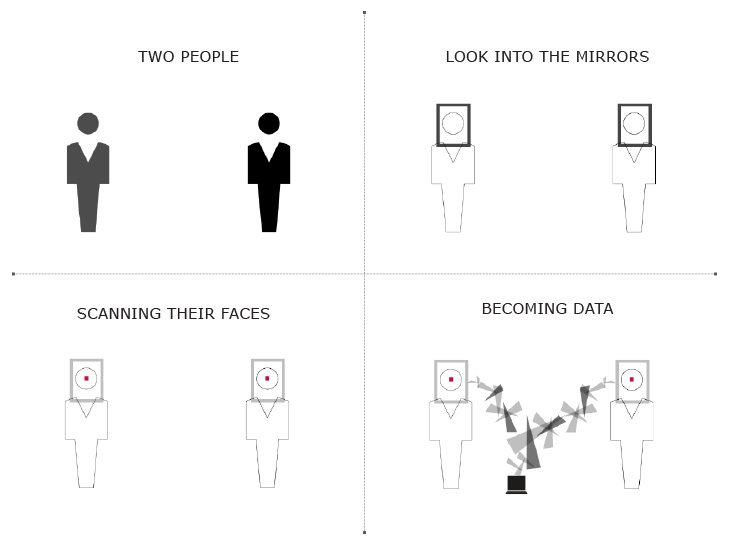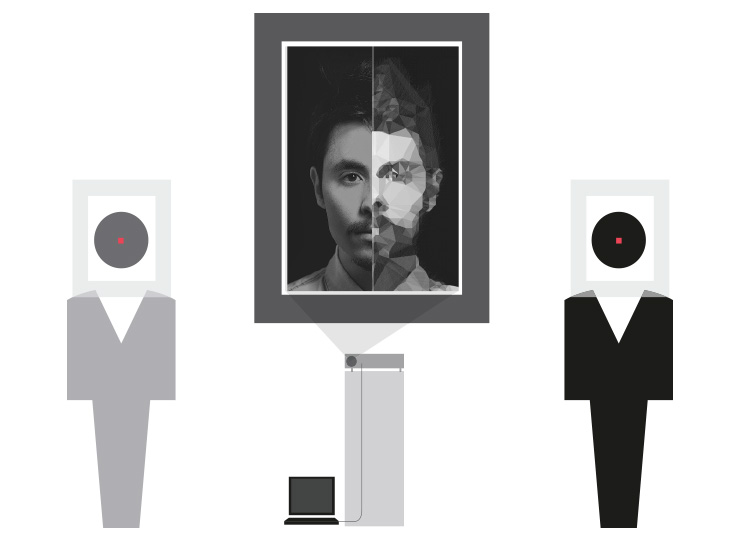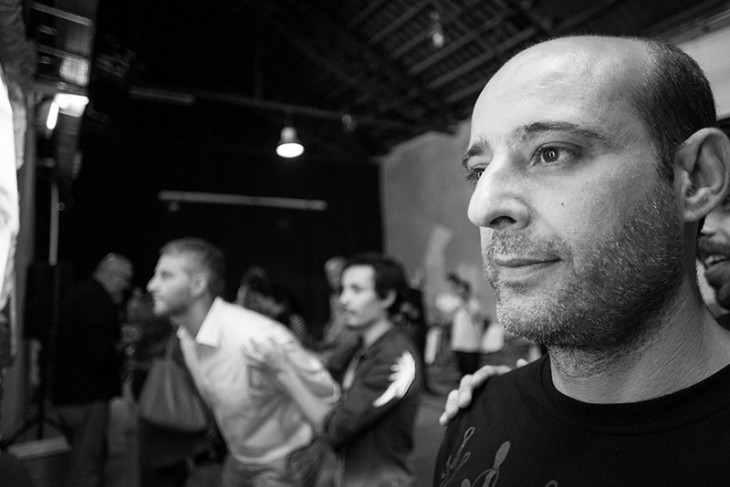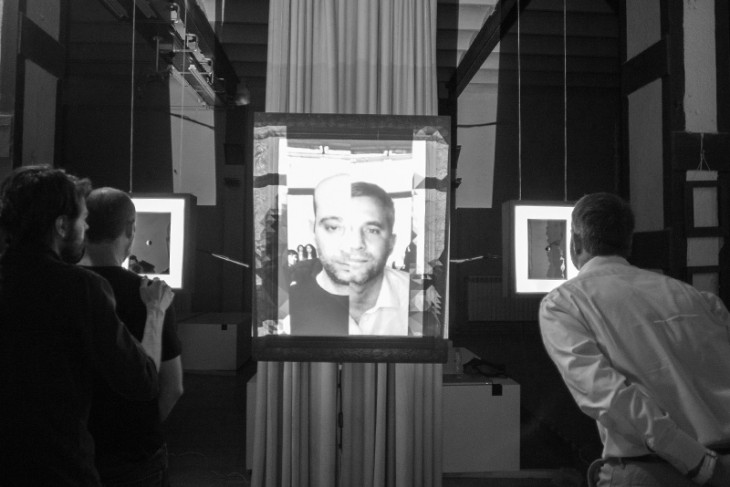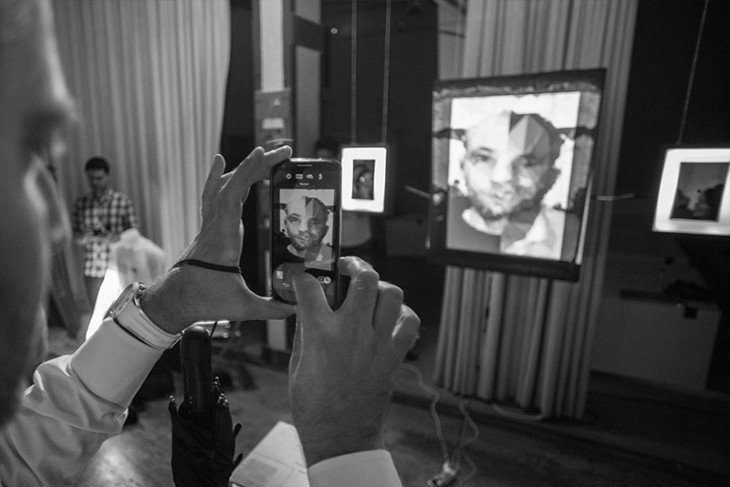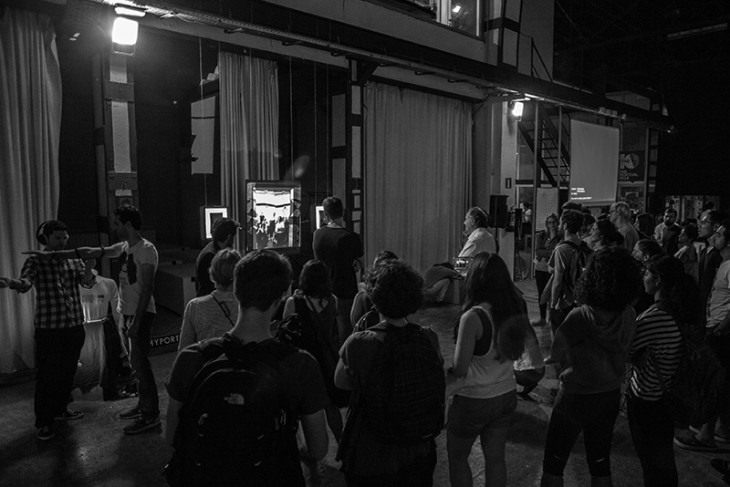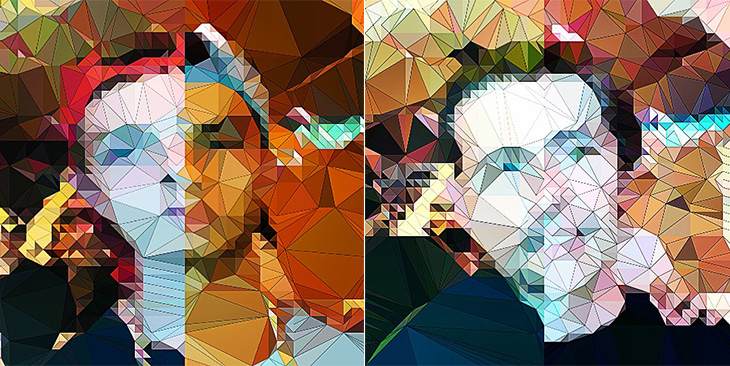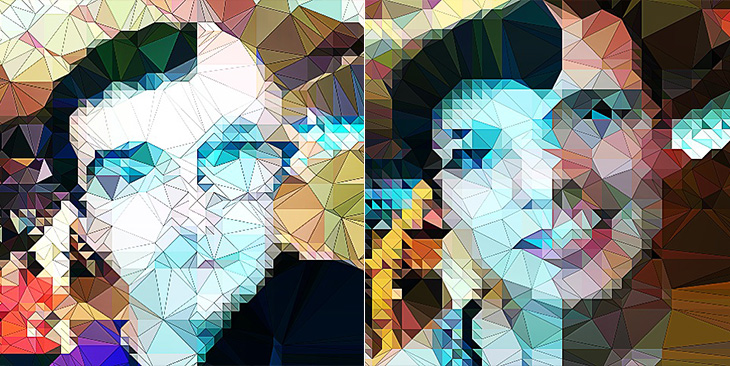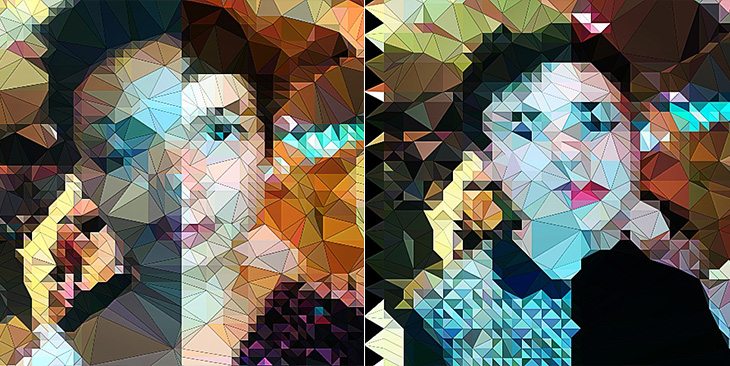Advanced Interaction Research Studio Final Presentation – IAAC 2014 Barcelona 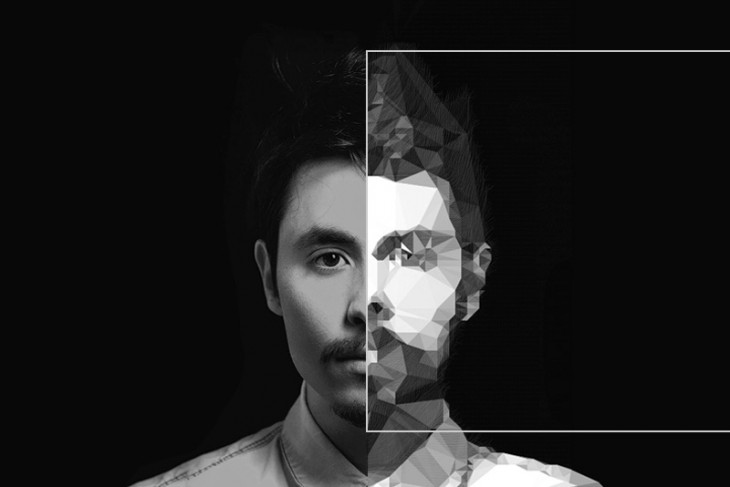
Since we have memory, we have been fascinated with the image, it has the power to last in time, create identity and find a perfect spot in our collective imagination as society. Portrait is a complex visual exercise with huge impact in the visual culture development of our society. We have seen that trough history , and that is why we are so attracted to explore it from the perspective of new technologies and new challenges as creators of the information age.
In one hand, as humans and digital citizens we are in constant evolution, so our visual representation need to have the same attribute: be evolutive, able to change in real time and offer infinite possibilities; and that is possible with the actual tools that we have now days. We can put together very complex process in simple functions to obtain unpredictable results.
On the other side, take a look at the process of visual creation, where there is always two roles: be observed and be the observer. At the end a collective exercise. Based on that we decide to create an installation were the portrait an exercise of mutual creation, where two strangers meet in a moment and work together to create an unexpected visual result. As interaction students we were very interested in do an experiment and a research into the phenomena of collective reaction, finding an excuse to connect our identities and create something together. At the end is the representation of how we act as society: we work together to evolve.
Portrait Evolution
A portrait is a painting, photograph, sculpture, or other artistic representation of a person, in which the face and its expression is predominant. The intent is to display the likeness, personality, and even the mood of the person. For this reason, in photography a portrait is generally not a snapshot, but a composed image of a person in a still position. A portrait often shows a person looking directly at the painter or photographer, in order to most successfully engage the subject with the viewer.
The portrait evolution in a social context is nothing else than project our physical being for the eternity, maybe the generic idea of the visual power is just an endless amount of images accumulated one on top of another with out representing any identity in the virtual reality, a reality filled by the excessive powers of photo-manipulation, a reality in which the real time and the purity of a portrait is lost and doesn’t represent at all the possibilities of the new digital era. Taking a look into the new technologies involved in the creation of the portrait now days, is when we can see the real qualities that define a portrait in our age. If we look back we can analyze how we play with matter is an evolutive experiment. Oleo, Stone and Pixel are a clear visualization of a civilization mutating to a systematic virtual reality.
The Concept
Psychological projection is a theory in psychology in which humans defend themselves against unpleasant impulses by denying their existence in themselves, while attributing them to others.For example, a person who is rude may constantly accuse other people of being rude. A great part of this subconscious identity that defines our personality influences drastically in our capacity to associate our deepest desires to images in which we found our darkest and also beautiful desires.
It is know that our mind project visual ideas about everything is around us, we are not sure if what we see is identical to what the others see, but we are sure that what we can imagine, is really what we desire. The term Hypocresy reveals true or lie, everything depends on the suject’s point of view. Any behavior or action or fact could be involved into the idea creation process, in this case a portrait, which is the hypocresy projection of new individual that can change infinite times and has the ability to answer to its environment in real time.
Hyperreality is a term used in semiotics and postmodern philosophy to describe an inability of consciousness to distinguish reality from a simulation of reality, especially in technologically advanced postmodern societies. Hyperreality is seen as a condition in which what is real and what is fiction are seamlessly blended together so that there is no clear distinction between where one ends and the other begins. It allows the commingling of physical reality with virtual reality (VR) and human intelligence with artificial intelligence (AI).Individuals may find themselves for different reasons, more in tune or involved with the hyperreal world and less with the physical real world.
The Information Society
An information society is a society where the creation, distribution, use, integration and manipulation of information is a significant economic, political, and cultural activity. The aim of the information society is to gain competitive advantage internationally, through using information technology (IT) in a creative and productive way. The knowledge economy is its economic counterpart, whereby wealth is created through the economic exploitation of understanding. People who have the means to partake in this form of society are sometimes called digital citizens. This is one of many dozen labels that have been identified to suggest that humans are entering a new phase of society. The markers of this rapid change may be technological, economic, occupational, spatial, cultural, or some combination of all of these. Information society is seen as the successor to industrial society. Closely related concepts are the post-industrial society (Daniel Bell), post-fordism, post-modern society, knowledge society, telematic society, Information Revolution, liquid modernity, and network society (Manuel Castells). The information society is a necessary concept to contextualize a new individual that grows from the data, evolve as a machine that portraits our identity, transform ourselves into real digital citizens and has a purpose produce and protect us in the virtual world.
Digital Citizen
A digital citizen refers to a person utilizing/using information technology (IT) in order to engage in society, politics, and government participation. K. Mossberger, et define digital citizens as “those who use the Internet regularly and effectively.” In qualifying as a digital citizen, a person generally must have extensive skills, knowledge, and access of using the Internet through computers, mobile phones, and web-ready devices to interact with private and public organizations. (These factors naturally preclude many from becoming fully realized as ‘digital citizens’ such as people who are illiterate and those who have no viable way of accessing the Internet). People characterizing themselves as digital citizens often use IT extensively, creating blogs, using social networks, and participating in web journalism sites. Although digital citizenship potentially begins when any child, teen, and/or adult signs up for an email address, posts pictures online, uses e-commerce to buy merchandise online, and/or participates in any electronic function that is B2C or B2B, the process of becoming a digital citizen goes beyond simple Internet activity. In the framework of T.H. Marshall’s perspective on citizenship’s three traditions (liberalism, republicanism, and ascriptive hierarchy), digital citizenry can occur alongside the promotion of equal economic opportunity, as well as increased political participation and civic duty. Digital citizenship eliminates exclusionary elements of ascriptive hierarchy in that the Internet does not exclude those wish to participate in its realm based on race, religion, or class – elements previously used to exclude people from even becoming traditional citizens.
The digital citizen is the main ingredient of this new image, the creation of visual information in real time is vital for this new individual existence. We can define our levels of codification and be visibles or invisibles, transform our visual appearance second to second, or be many versions of ourselves, explore our limits with out knowing how other see us. A self-portrait that can define our identity infinitely.
From Multi-Personality to Privacy
Dissociative identity disorder (DID), or multiple personality disorder (MPD), is a mental disorder on the dissociative spectrum characterized by at least two distinct and relatively enduring identities or dissociated personality states that alternately control a person’s behavior, and is accompanied by memory impairment for important information not explained by ordinary forgetfulness. These symptoms are not accounted for by substance abuse, seizures, other medical conditions, nor by imaginative play in children. Diagnosis is often difficult as there is considerable comorbidity with other mental disorders. Malingering should be considered if there is possible financial or forensic gain, as well as factitious disorder if help-seeking behavior is prominent. In our context, multi-personality has evolved from be a disease to a more light adapted concept: New identities in the virtual reality, impersonation, deception, cheat to name the most common; open possibilities of world where you can be anybody. With that in mind we can think from the other side and understand that maybe this is a new tool that is interested in protect the virtual enviroment to evolve with the data and the individuals we meet everyday.
Privacy changed, it has evolved from being a window to a button. Now we can have a superficial read of any person even if we dont have exact details. We can identify a person through its face between millions of tags, this is how our portrait define the first approach to our data. Millions of bits can be encrypted and used to protect our identity.
Endless Portrait
An infinite world of possibilities, multi visual-personalities, that can define moods, intellectual positions, feelings and ideas that we haven’t thought before.
Multi-personality is not a disease from the modern society, is a defensive mechanism and a tool that we use to our daily live. We talk about beauty on the virtuality, we can talk about, millions of pixels, points or moving particles in a 3d space, endless possibilities to perceive our digital nature.
Data Face
A facial recognition system is a computer application for automatically identifying or verifying a person from a digital image or a video frame from a video source. One of the ways to do this is by comparing selected facial features from the image and a facial database. It is typically used in security systems and can be compared to other biometrics such as fingerprint or eye iris recognition systems.
Some facial recognition algorithms identify facial features by extracting landmarks, or features, from an image of the subject’s face. For example, an algorithm may analyze the relative position, size, and/or shape of the eyes, nose, cheekbones, and jaw.These features are then used to search for other images with matching features.Other algorithms normalize a gallery of face images and then compress the face data, only saving the data in the image that is useful for face recognition. A probe image is then compared with the face data. One of the earliest successful systems is based on template matching techniques applied to a set of salient facial features, providing a sort of compressed face representation.
Recognition algorithms can be divided into two main approaches, geometric, which looks at distinguishing features, or photometric, which is a statistical approach that distills an image into values and compares the values with templates to eliminate variances. Another emerging trend uses the visual details of the skin, as captured in standard digital or scanned images. This technique, called skin texture analysis, turns the unique lines, patterns, and spots apparent in a person’s skin into a mathematical space.
Delaunay Process
A Delaunay triangulation for a set P of points in a plane is a triangulation DT(P) such that no point in P is inside the circumcircle of any triangle in DT(P). Delaunay triangulations maximize the minimum angle of all the angles of the triangles in the triangulation; they tend to avoid skinny triangles. The triangulation is named after Boris Delaunay for his work on this topic from 1934. For a set of points on the same line there is no Delaunay
triangulation (the notion of triangulation is degenerate for this case). For four or more points on the same circle (e.g., the vertices of a rectangle) the Delaunay triangulation is not unique: each of the two possible triangulations that split the quadrangle into two triangles satisfies the “Delaunay condition”, i.e., the requirement that the circumcircles of all triangles have empty interiors. By considering circumscribed spheres, the notion of Delaunay triangulation extends to three and higher dimensions. Generalizations are possible to metrics other than Euclidean. However in these cases a Delaunay triangulation is not guaranteed to exist or be unique. Thanks to the creation of a new encrypted identity with multiple virtual features, we can think of a new virtual form of life in which humans can adapt and respond in real time to its informatic enviroment.
The multimedia evolves day by day in terms of aesthetics and techniques, that is why we are very concern about the creation of a more advanced and updated visual identity able to answer the needs of a technological society.
Interaction Social Creation
The project focus in the social creation experiment of a portrait between two or more individuals, also search the meaning of a portrait in a digital era and how this is changing the way we percieve our identity. A new identity with the power of being adaptable and evolutive. This new experiment allows us to project thousands of variations in the virtual world, many configurations that lead us close to a more sensible portrait.
The installation starts wih a facial recognition process of two people. The system recognize them, compute the capture a produce 3 simple results: first, a merged portrait representing a new identity. Second multiple configurations based on that captured face, it allows to transform the visual configuration of the same face in real time. And third, complex series of data that can be encrypted in this visual representation. Then we create an interface to storage all portraits into libraries. This libraries are conected to an uploading system that share the images on the internet. Our vision is to create one of the biggest libraries of portraits in the virtual world.
The aim of this performance is to create a more artistic and emotional scene, where the user is in front of a mirror question its identity to then be reflected in a merged result with the other user. The performance starts wit two people standing in front of two mirrors located side by side next to the central frame, there the system captures their faces through webcams hidden on the frames.
Performance Social Creation
The data is recorded and is loaded by a set of rules in Processing, where and algorithm tranforms the points into a merged triangulation based on delanuay process trying to find the right match between the points read from two faces. A projection show in the central frame the result through a growing animation until creates the new virtual identity.
Is a new collective experience where the user is integrated into the process of virtual identities generation and understand the visual possibilities of its identity on the virtuality.
Engaging
The aim is to communicate a clear and simple idea so any individual can be part of this revolution, that is why we decide to create a portrait cloud with all the portraits generated everytime the installation runs. Then we can share the results and the big scope of the project, so people can feel related with the concept and understand the possibilities of multi-creation in real time. Inside the stage we can find a section where people can see all the portraits uploaded to instagram and facebook accounts, so they can share their creations with other users through social networks.
Then the idea of digital fabrication comes to live, we can use this digital information and extract it to create 3d printed models of the faces, presenting new possibilites of this experiement, where we can touch what we create on the virtual reality.
Hyportraits Performance
Performance a Social Creation
The experiment saw the light for the first time at Sonar+D Market Lab at 2014 Edition of Sonar Festival, an international advanced music and new media art festival based on Barcelona between June 12.13.14. During the 3 days the installation creates more than 200 hyportraits, meaning that more that 400 people participate in the experience. The project also had a lot of exposure on diffretent medias, tv, magazines, news papers. Followers on the social networks and sharing of the creations. Here some of the results:
Please follow the project at:
And read the interview for “EL PAIS”, spanish newspaper:

